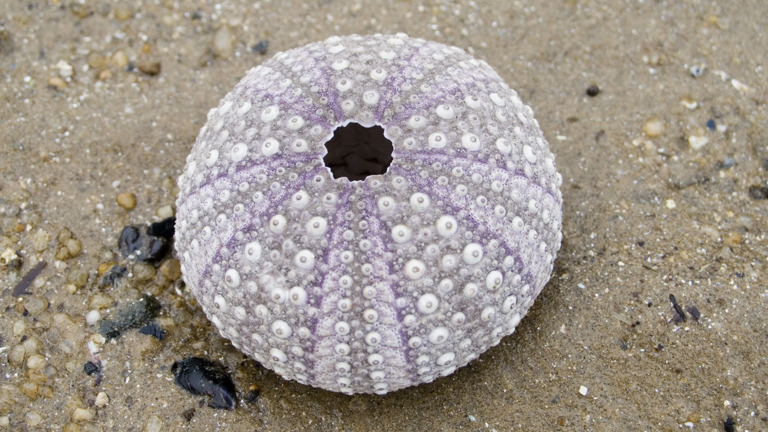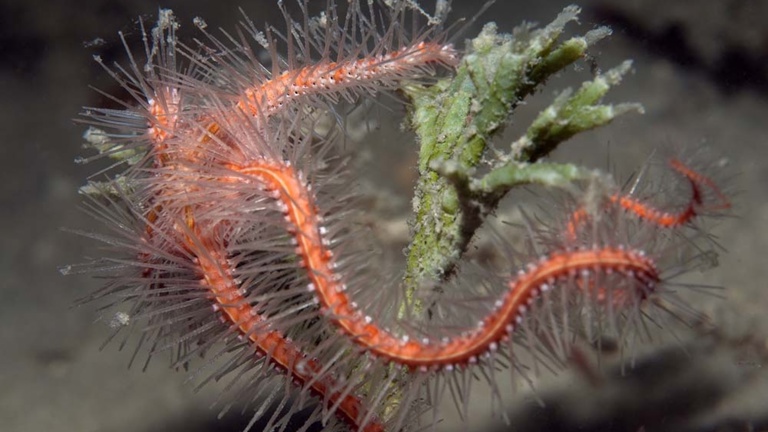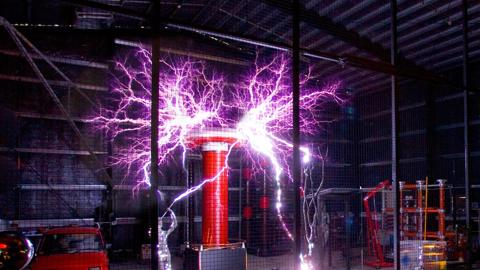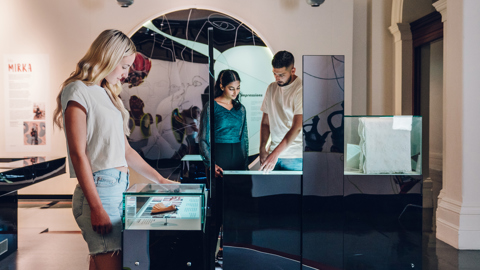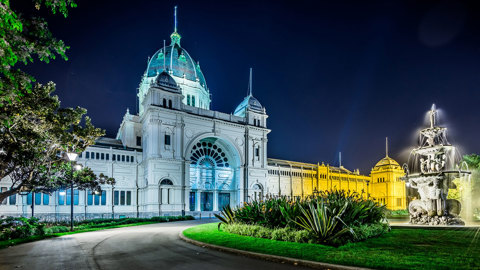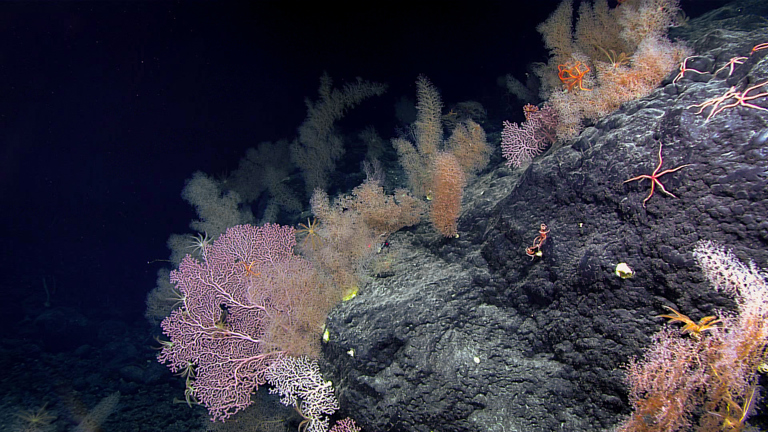
Why our planet’s climate depends on its darkest depths
Hidden beneath the waves, in a part of the world most of us will never see, lie the lowest valleys of the seafloor. But every day, the deep sea environment helps control our climate, while ocean currents breathe life into the deepest places on Earth.
Exploring the deep sea is a vital research area of Museums Victoria Research Institute, and of other organisations seeking to understand our planet.
The deepest trenches of the ocean are peaceful.
‘It’s as quiet as it’s ever going to get,’ says Prof. Alan Jamieson, marine biologist, founding Director of the Minderoo UWA Deep Sea Research Centre and one of few to visit ocean depths of over 10 km.
‘The darkness is almost satin. It’s just incredible. And you go down and you see these beautiful creatures.’
According to somewhat arbitrary human definitions, the deep sea begins where the light fades, at around 200 m deep. Above, sunlight pierces the surface, bathing algae and underwater plants in enough light for photosynthesis.
Sink down and pass the 1000 m mark, and it’s total darkness right down to the deepest point of the seafloor, about 11 km below the surface in the deepest parts of the Mariana Trench.
‘The deep ocean is generally a very stable environment,’ says Esmee van Wijk, a physical oceanographer at CSIRO Environment.
‘It’s typically also quite cold… in-between 0 and 3 degrees (Celsius) at deeper depths in the Southern Ocean. And the pressures there are extreme.’
The cool, peaceful expanse of the deep sea may feel a world away, and yet it takes up a huge portion of the planet.
‘About 95% of the volume of the ocean is found in waters deeper than 200 m,’ says van Wijk.
‘And so it’s one of the largest ecosystems on the planet.’
Hidden below the waves, this enormous environment is not isolated from the rest of the planet. In fact, the deep sea connects the globe through a current that travels the entire Earth:
The Global Ocean Conveyor Belt.
What is the Global Ocean Conveyor Belt?
The Global Ocean Conveyor Belt is a system of deep ocean currents that moves water around the entire globe. By moving water, it also moves heat, redistributing warmth around the planet.
As a result, the ocean at the equator doesn’t get too hot. The ocean at the poles doesn’t get too cold. The climate remains stable and steady.
How does the Global Ocean Conveyor Belt work?
While the moon pulls the tide and wind pushes currents in the surface waters, the Global Ocean Conveyor Belt is driven by temperature and salinity.
It starts with the sea ice. In the Arctic and Antarctica the ocean freezes, but the salt can’t freeze with it. The salt is pushed out of the ice and left behind to mix with the water.
‘The water column beneath the ice becomes saltier, which makes the water denser,’ says van Wijk. Cold water is also denser than warm water.
‘The cold, salty water formed on the Antarctic continental shelf is dense enough to sink from the shelf all the way to the bottom of the ocean.’
‘Cold, salty waters also form in the North Atlantic.’
Although travelling at an average of only 1 cm per second, this constant movement of water drives vital processes for Earth’s marine ecosystems.
Why is the Global Ocean Conveyor Belt important?
Dense, salty water languidly cascades into dips and valleys of the ocean’s rugged seafloor. As it oozes past communities of deep-sea animals, the current delivers vital nutrients and oxygen to the ecosystems of the abyss.
Life in the deep needs oxygen just as much as ourselves.
‘When you’re forming those dense, cold waters, they’re often oxygen-rich, and so these waters are bringing oxygen into the deep,’ says van Wijk.
‘You can think of it as a set of lungs ventilating the deep ocean.’
The Global Ocean Conveyor Belt also brings water back up to the surface. Where the water rises from the deep, it carries nutrients previously trapped in deeper ocean layers.
‘If [the nutrients] get into the sunlit zone, then they become available for phytoplankton,’ says van Wijk. Phytoplankton are microscopic algae that use sunlight and nutrients to grow, forming the base of marine food webs just like plants on land.
‘The phytoplankton can start growing rapidly and can create phytoplankton blooms, because they’ve got all those nutrients available to them that were previously locked away in the deep ocean.’
Rising and falling, the currents of the deep sea take about 1000 years to fully circulate the globe. They carry nutrients, oxygen and heat to places on Earth that would otherwise be devoid of life.
They also carry carbon, stored in the deep sea by the action of the biological carbon pump.
What is the biological carbon pump?
If you could shine a torch into the velvet darkness of the tranquil seafloor, the light would catch flakes of matter softly tumbling from the surface kilometres above.
This rain of nutrient-rich particles is often called marine snow. The snow is made from dead animals, plants, algae and poo sinking from the surface.
If you were to watch the snow fall, you’d be watching what’s known as the biological carbon pump in action.
At the base of the food web, algae and plants take in carbon as carbon dioxide.
When animals eat these plants, they take the carbon into their bodies. When these animals are eaten, the carbon moves up the food chain and so on. But the food chain doesn’t continue upwards forever.
When animals die, the carbon locked inside sinks with their bodies to the bottom of the ocean. The carbon is also excreted in their poo.
The entire process creates a funnel of carbon travelling to the very bottom of the ocean. This transfer of carbon from the surface ocean to depth by sinking organic matter is known as the biological carbon pump.
Here, it becomes part of the sediment beneath, or nourishes the filter-feeding animals that consume this drifting organic matter.
Why does the carbon pump matter?
In the oceans, the biological carbon pump is a form of blue carbon storage that removes carbon from the atmosphere. When carbon remains in the atmosphere as carbon dioxide, it traps heat and contributes to global warming.
‘Because the deep ocean currents move very slowly through the ocean, [carbon] stays in the deep ocean for really long periods of time, out of contact with the atmosphere,’ explains van Wijk.
And while the seafloor isn’t the only place in the world that stores carbon, the seafloor is special; it’s the only environment where carbon is pushed back into the Earth in marine trenches.
‘The very deepest place in the world are trenches,’ says Prof. Jamieson. Trenches form where one section of the Earth’s crust is pushed beneath another.
As it sinks beneath, it carries rock and sediment—and all the carbon stored within it—into the Earth’s mantle. The movement is slow, at about 2 cm per year, but has been underway for millions of years.
‘The only places actually getting rid of [carbon] are the deepest places in the world.’
Every day, the climate is being affected by the vast marine environment.
Why the deep sea deserves our care
Without the oceans, life on Earth would not be the same. Our climate and our planet’s health are intricately tied to the workings of places far, far beneath the ocean’s surface.
Despite our preference for dry land, Earth is a planet of oceans. The deep sea is not a faraway place, distant from ourselves. It’s not a realm of monsters, but of life perfectly adapted to its unique conditions.
‘I think some of the problems we deal with when we’re thinking about the deep sea… is that it’s a scale we don’t comprehend because we can’t experience it with our own bodies,’ says Prof. Jamieson.
‘It’s just so intrinsically imprinted on the brain that this is this horrible, gloomy, scary place. And that’s what we’re trying to overcome.’
Climate change, pollution and overfishing impact the deep sea, just as much as they harm our surface oceans.
‘I think we really need to look after the deep ocean not only for its climate services (such as storing ocean heat and carbon), but for all the other services it provides, and in its own right… it’s got so many amazing, wonderful creatures that live there,’ says van Wijk.
‘We have a responsibility to look after it.’
Prof. Alan Jamieson is a Professor at the Oceans Institute and the School of Biological Sciences at the University of Western Australia, and the founding Director of the Minderoo UWA Deep Sea Research Centre. He was the first British person to reach hadal depths (between 6000 and 11,000 m) and is an international authority on the Hadal Zone.
Esmee van Wijk is a Senior Scientist at CSIRO Environment. She trained as a physical oceanographer and marine biologist, is a co-chair for the Polar Argo Mission of the international Argo Program and currently leads the Under-Ice Argo array and co-leads the Deep Argo array for the Australian program.
By taking action on climate change we can reduce the harms of ocean heating, acidification and sea-level rise. Discover how you can play your part in helping to shape a thriving future for our oceans.






